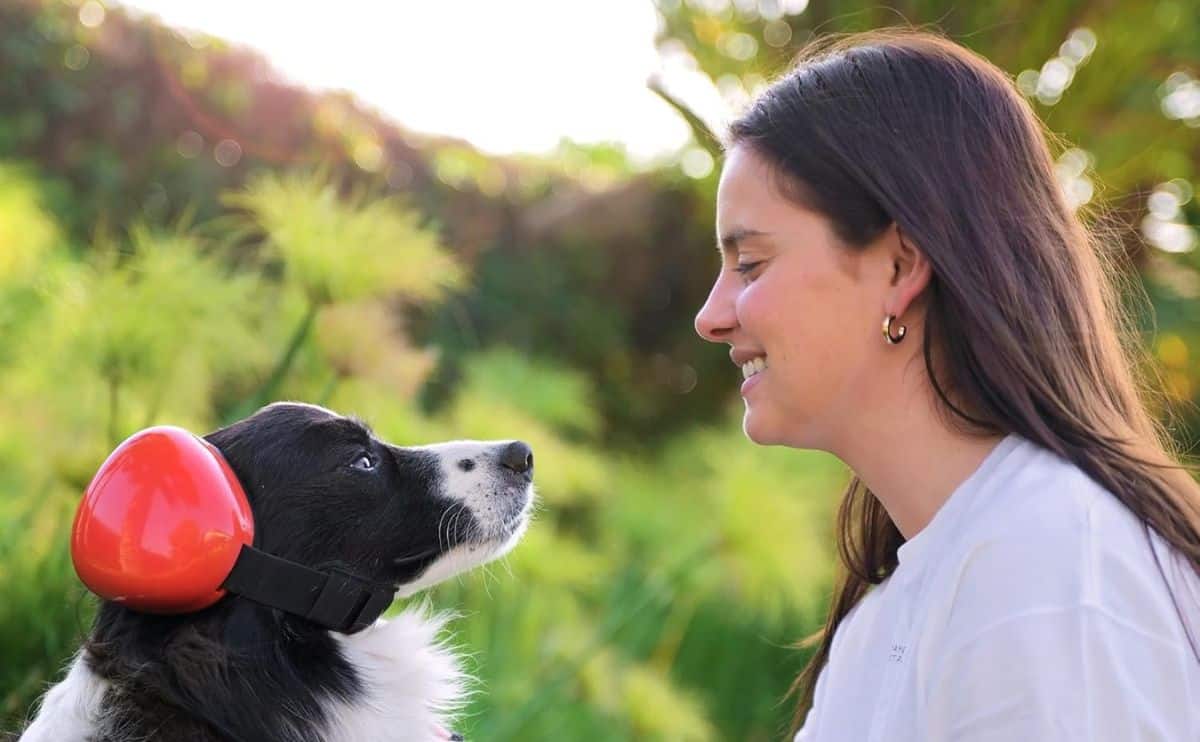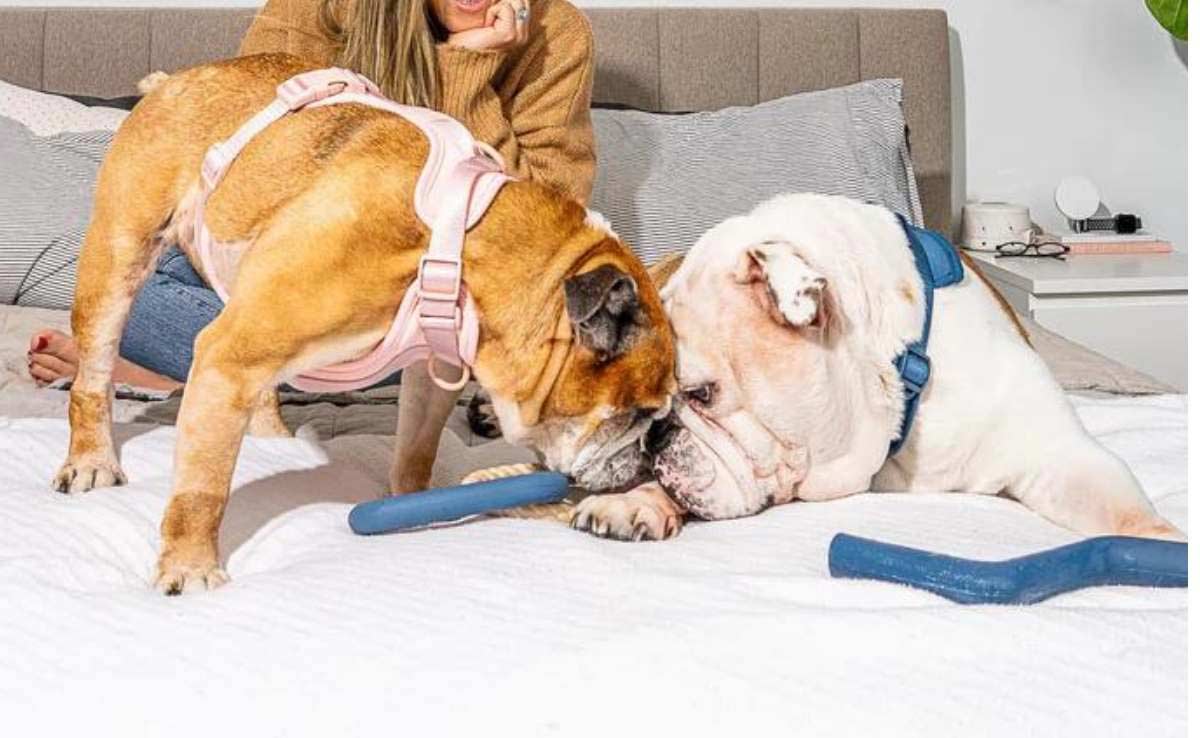15 Game-Changing Solutions To Stop Your Dog From Sliding On Slippery Floors
When you purchase through links on our site, we may earn a commission. Here’s how it works.
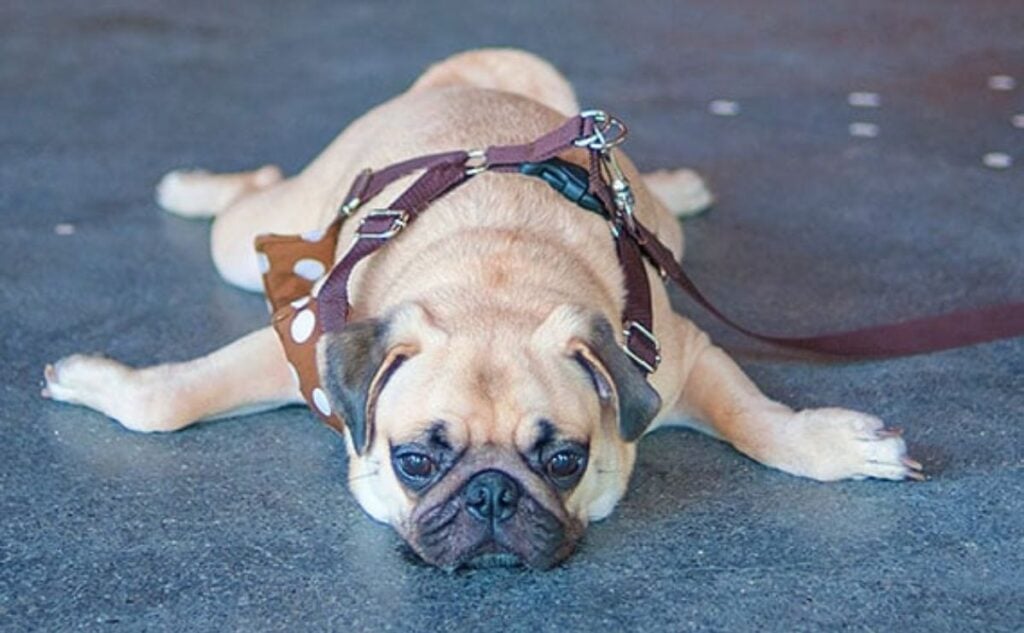
Is your pup stumbling around your floor like he’s on a slip n’ slide? Or maybe your old dog can’t stand up once he sits down? Chances are your flooring is hardwood, tile, laminate, vinyl, or polished cement. Sure, these floors may look great and be easy to clean. But to your dog, he might as well be walking on ice – he can’t get a grip. Your dog may look adorably cute as he clumsily stumbles around your floor or glides around like an ice skater. But these tumbles are seriously dangerous to his health.
Table of Contents
A young, healthy pup risks pulled muscles or torn ligaments. But if you have an elderly or special needs dog, it’s even worse. Those aggressive staggering movements can cause irreparable damage to older dogs with arthritis, spinal, joint, or hip problems.
These medical conditions can cause your dog’s legs to twist and his feet to slide out from under him when walking over slippery surfaces – you might even notice your dog’s hind legs doing the splits while he eats. A stumble or fall could mean an expensive trip to the vet. For the sake of your dog, you need to come up with a solution.

But slippery floors are more than just a fall hazard. Once some dogs lie down on a slippery floor, they can’t get up again. If your dog lies belly-down on the floor and looks like a starfish with his legs extended, he may be having difficulty getting a grip.
How Do Dogs Normally Get A Grip?
Dogs grip surfaces using their paws, which are specially designed to provide traction, though not always as effectively on slippery floors. Here’s the science behind it:
- Paw Pads: A dog’s paw pads are made of tough, flexible tissue that helps them grip different surfaces. These pads have a rough texture and a unique pattern, which increases friction when they walk on natural terrain like grass, dirt, or gravel. The deeper grooves in their pads help them dig into the ground for better traction.
- Claws: A dog’s claws, while not as sharp as a cat’s, still play a role in grip. They help “anchor” the dog to the ground, especially when running or making sharp turns. Claws can provide added traction on rough surfaces, but on smooth, hard floors, they don’t help much.
- Muscle and Joint Flexibility: Dogs have muscle and joint systems designed for flexibility and agility, which help them adjust their posture and keep their balance. Their legs and spine are built to help them navigate different terrains, but on slippery floors, their bodies may not be able to compensate for the lack of grip.
- Weight Distribution: How a dog’s weight is distributed across their paws also affects their grip. On soft ground, they can press down and use their weight to anchor themselves. On hard floors, the pressure isn’t enough to maintain stability, and they’re more likely to slip.
In short, dogs rely on the combination of their flexible paws, claws, and muscle control for grip. But on slick floors, these natural tools aren’t enough to stop them from gliding across the room like a pro ice skater.
Why Dogs Can’t Handle Slick Floors
Dogs can slide on slippery floors for a bunch of reasons, and it’s usually pretty funny—until they faceplant or injure themselves. Here’s why your pup may not be able to get a grip:
- Lack of Traction: Floors like hardwood, tile, or laminate are like a slip-n-slide for dogs, especially if they have small or flat paws. Without the grip they need, they’re bound to slide and crash into things when they try to walk or run.
- Nail Length and Condition: Long or unruly nails aren’t helping their cause! If a dog’s nails are too long or too smooth, they can’t get the traction they need to stay grounded, leading to some awkward slides.
- Age and Health Issues: Older dogs or pups with joint problems (like arthritis) might have a harder time keeping their balance. Weaker muscles mean they slip more easily when trying to walk.
- Breed-Specific Factors: Some dogs, like Dachshunds or Corgis, have low, long bodies and short legs that make it harder to stay upright on slick floors. They’re basically built to slip!
- Floor Surface and Finish: Shiny, polished floors, especially when wet, are a recipe for disaster. That glossy finish can send your dog slipping and sliding like they’re in a racing video game.
- Excitement or Speed: When your dog gets all excited, they forget to slow down and just go full speed ahead. And boom—sliding into the next room!
- Inexperience or Lack of Coordination: Puppies or dogs who aren’t used to smooth floors might be in for a surprise. They don’t always know how to navigate those slick surfaces, so they just slide around trying to figure it out.
How To Keep Your Dog From Slipping On The Floor
Concerned for the safety of your pup? Don’t worry, we have you covered. Check out these 15 anti-slip solutions to give your dog extra traction on slippery floors.
1. Fix Those Cracks (In Your Pup’s Paws)

Your dog already has built-in traction control. I’m talking about their paw pads. However, these paw pads can also cause your dog’s legs to slide out from underneath them. You know the tires on your car? As they wear down or get damaged, they don’t grip the road properly. Well, your pup’s paw pads work the same way. If they are dry, cracked, or worn down, they can’t grip your floor. A quick spot check will determine whether your dog’s paw pads are the cause.
One of the most popular ways to fix damaged paw pads is paw balm. Think of it as moisturizer designed for your pup’s paw pads. Application couldn’t be more straightforward. Rub the paw balm over the paw pads, massaging it in with your fingers. Natural Dog Company’s Pawtection is a top choice and even comes in a stick for less messy application.
If you have a dog who hates you touching their paws, a lick mat can work wonders. By smearing a dollop of pet-safe peanut butter over the mat, your dog will be distracted while you massage their paws – Lickmats work great for dogs who hate grooming and baths, too!
It is worth mentioning that cracked paw pads can be caused by allergies, nutritional problems, and other medical conditions. When in doubt, consult your vet.
2. Give Your Pup An Anti-Slip Manicure
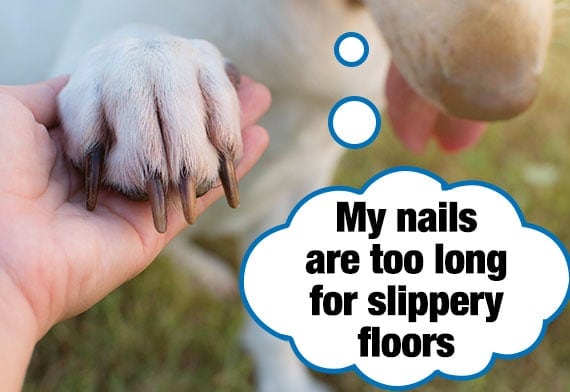
Your anti-slip solution could be as simple as giving your dog’s nails a trim. When it comes to slippery floors like wood or tile, long nails can make all the difference in how well your dog can grip the ground. Here’s why: when a dog’s nails grow too long, they start to shift the weight distribution when walking. Instead of placing most of their weight on their flexible, padded toes, they end up placing more weight on the hard nails, which are far less effective at providing traction.
Imagine trying to walk on a slick floor while balancing on your fingertips? That’s what your dog’s long nails are doing on smooth surfaces like hardwood or tile. Hard nails just can’t grip those surfaces the way their paw pads can. The result? A slip-and-slide every time your pup takes a step.
This is where the magic of a good nail trim comes in. By shortening the nails, you allow the dog’s paw pads—those soft, squishy pads designed for gripping—to make full contact with the floor. Once the nails are trimmed, your dog can distribute their weight more evenly on their pads, improving traction and reducing the chances of sliding around.
To tackle those slippery floors and keep your pup safe, consider tools like the Coastal Pet Safari Professional Dog Nail Trimmers. These trimmers are a popular choice for dog owners looking to keep their dog’s nails in check and ensure better traction. Regular nail trimming not only helps prevent your dog from slipping but also supports their overall paw health.
See our reviews of the 5 best dog nail clippers, including scissors or guillotine-style trimmers. We also review the best dog nail grinders if you prefer a powered option. And check out our step-by-step guide on how to trim your dog’s nails, including safety tips.
3. Give Your Pup’s Feet A Trim For Better Grip
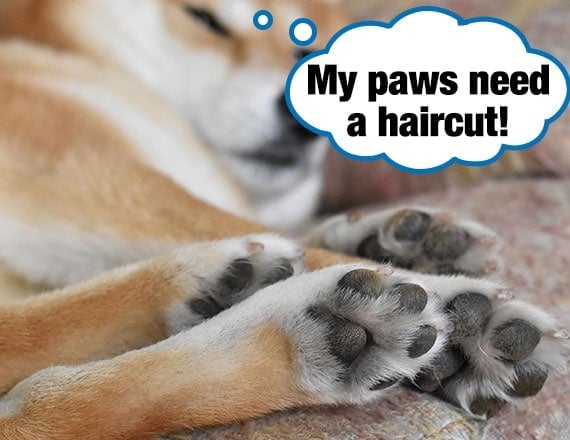
A quick haircut could be all that is needed for improved traction on hard floors. You see, your dog has hairy feet. Not just on top but underneath, too. If you lift your dog’s paw, you’ll see fur between his paw pads. As this hair grows longer, it can cover the paw pads. When your pup takes a step, he is stepping on this long fur, causing him to slip and tumble. It’s like trying to run in a pair of furry slippers. Not recommended, by the way.
That long paw pad hair has to go. It’s time to groom your dog’s furry feet. A grooming shaver will deal with the long hair that falls over the top of the toenails. But to trim the fur that grows between the paw pads, many owners find it more precise to use a pair of grooming scissors, like these Pet Magasin Grooming Shears that have a rounded safety tip.
Don’t feel comfortable trimming your dog’s foot hair? Reach out to your local dog groomer – they will have your pup groomed in no time! With your pup’s long hair gone, there is nothing to come between his paw pads and the floor.
4. Slip-Proof Your Pup With Doggy Socks

Have you ever put on a fresh pair of socks only to go sliding across the floor like Tom Cruise in that scene from Risky Business? No judgment if you have. But it might surprise you that a good pair of socks could actually stop your dog from slipping on hard floors. But just not any pair of socks. Dog socks. You see, dog socks are a little different – they feature non-slip grips on the underside! These grips help your pup gain traction on a slick floor.
For the best results, size matters. Just like you wouldn’t want to wear socks that are too tight or too loose, the right-sized socks are essential for your pup’s comfort and grip. The DOK TigerToes Grip Socks are a top choice among pet owners because they offer maximum grippage with their high-quality, non-slip rubber soles. With seven different sizes available, these socks can accommodate nearly any pup, from tiny Chihuahuas to larger breeds like Golden Retrievers.
If you want to completely destroy your dog’s street cred, choose a style similar to the socks you wear. Matching sock buddies!
5. Keep It Steady: Wear Shoes Inside

Not feeling socks? Why not try a pair of dog boots instead. Dog boots are designed to help your dog gain traction when hiking across all types of terrain, including loose rocks and boulders. They’re also helpful to protect your pup’s paws in cold and hot weather. In comparison, gripping your slippery floor isn’t even a challenge for a good pair of dog boots.
Okay, so boots might be overkill for hard flooring, but there is no denying that they are a great way to slip-proof your pup. Plus, boots have a significant advantage over socks. They have velcro straps to keep them attached to your dog’s feet all day long. Dog boots, like Ruffwear Grip Trex Dog Boots, come in a wide range of sizes, from tiny Pomeranians to hulking Labradors. Make sure you measure your dog’s paws before buying. Loose-fitting boots could cause your pup to trip while running around your home.
See our reviews of the best dog shoes for hot pavement, cold weather, and hiking to find the ideal booties for your pup’s needs.
6. Slip On Some Toe Nail Grips
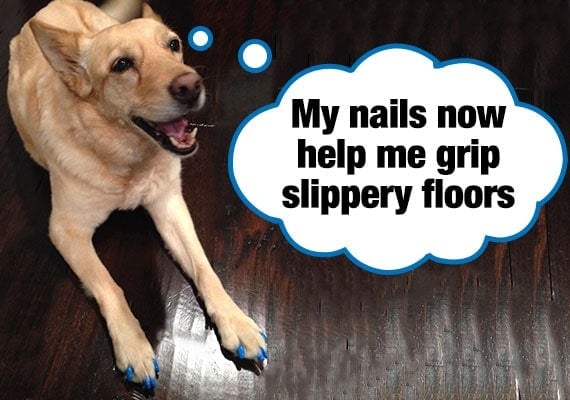
Your dog naturally uses their toenails for gripping, and outside, this built-in traction system works like a charm. Have you ever watched your dog chase a squirrel up a steep hill or sprint across rough terrain? That’s their toenails in action, digging into the ground to give them all the grip they need. It’s nature’s own traction control, helping your dog navigate outdoor obstacles with ease. But when it comes to smooth indoor floors, things aren’t so simple. On slick surfaces like hardwood or laminate, your dog’s toenails don’t have anything to hold onto. That’s where dog toenail grips come in.
A dog toe grip is essentially a small piece of rubber that fits snugly over each of your dog’s toenails. Think of them like little boots for your dog’s nails! These grips don’t look like much, but they’re incredibly effective at solving the slipping problem. One of the most popular and effective products is Dr. McHenry’s Dog Toe Treads. These treads come in several sizes to fit various breeds, so you can find the perfect match for your dog.
So, how do these grips actually work? The magic is in friction. Rubber naturally grips slick surfaces like hardwood or tile, which is exactly what your dog needs to prevent slipping. These small but mighty treads help your dog get the extra traction they need, making it easier to walk, turn, or even run on slippery floors without slipping and sliding. Even though they’re subtle, they make a huge difference.
One of the biggest advantages of toenail grips is that they’re often more comfortable and less intrusive than full-on dog boots or socks. Many dogs are less likely to mind toenail grips because they’re not as bulky and don’t cover the entire foot. It’s a simple yet effective way to keep your dog safe and mobile on slick surfaces, whether they’re zooming around or just trying to keep their balance.
7. Control Roaming With A Gate
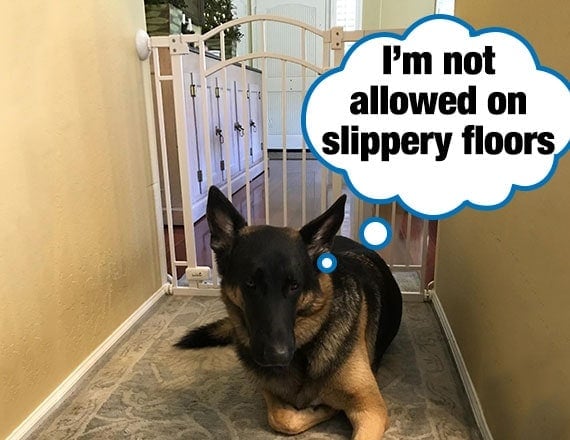
If you have mixed flooring, such as carpet and tiles, then you have a unique solution available. Let’s say that your kitchen is the problem, and your dog keeps falling on the slippery tiles. The solution is to keep your dog off the tiles altogether. When it comes to blocking off individual rooms, a pet gate, like this Regalo Easy Step Gate, works wonders. Think of it as a baby gate but for your dog. Set the gate up in the doorway, and your dog will no longer be able to get through.
Another benefit of using a pet gate is that it gives your dog a safe, designated area to roam—perhaps a cozy carpeted room or a space with a rug or runner where they can still feel like they have the freedom to move around without the risk of sliding all over the place. Plus, it’s a low-maintenance solution that doesn’t require you to alter your home’s layout or cover every inch of the floor with non-slip mats.
If the Regalo gate isn’t a good match for your home, read our reviews about the best dog gates for different sizes and needs.
8. Mat Your Floors
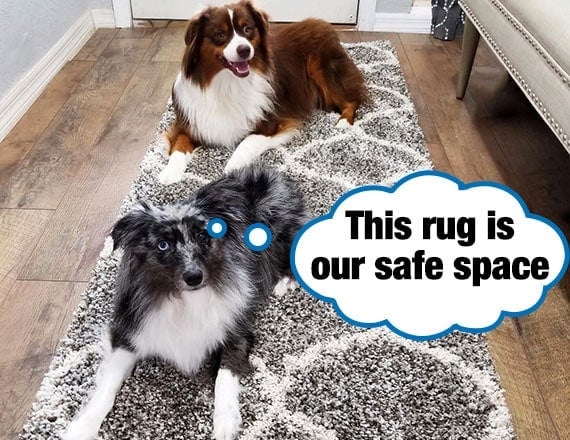
If you are all about aesthetics, then you probably won’t like this solution – it involves covering up your stunning oak hardwood floor. For the health and safety of your dog, it’s worth it. But you can’t just cover your floor with blankets or towels – these move around underfoot and can even make slipping worse.
I spoke to one dog owner whose dog wouldn’t stop skidding as he ran down the hall. As he tried to stop, he would slip headfirst into the wall. The solution? She placed a runner rug over the wooden flooring in her hall. Now, her dog could easily change direction and dash off into the adjoining doorway without slipping.
Now, rugs can get expensive. (Although the nuLOOM rug brand has several affordable options.) Another dog owner suggested using yoga mats instead. By placing each mat end to end, you can create a non-slip walkway for your dog, allowing your pup to navigate even the slipperiest floors without setting foot on it.
If you decide on a rug, make sure it doesn’t slip when your dog walks on it. A slippery mat can almost be as dangerous as a smooth floor! Does your rug slide around? Use a Gripper Pad. This will hold your rug in place even if a large dog runs over it.
9. Wax Those Pads
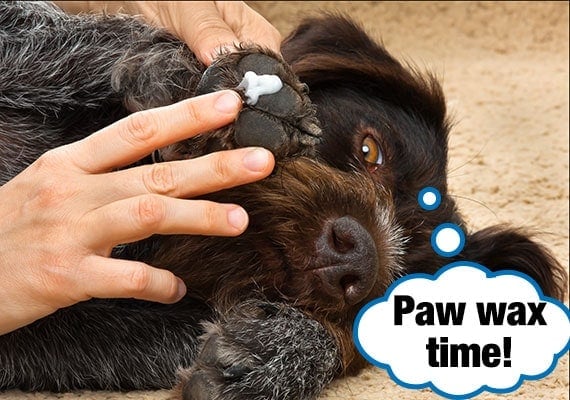
Paw wax is often used to protect paws from ice, snow, and even hot pavements. But it has another advantage that few people talk about – it can provide extra grip on slippery surfaces. Application takes seconds. Spread a small amount of wax over each paw. The wax forms a barrier that provides your dog with extra traction.
Out of all the paw waxes available, none is more popular than Musher’s Secret. What I like most about it is that it’s non-staining. I have mixed flooring in my home. The wax stops my dog slipping on the tiled floor, but also won’t mark my carpet. It’s also 100% natural and nontoxic — score!
Now, you do have to regularly apply Musher’s non-slip wax to the bottom of your dog’s paws. I was able to get about a day out of each application, although I would need to reapply if my dog went outside. As you might have guessed, paw wax works best as a temporary solution to offer your dog extra grip. Especially if your dog doesn’t like having his paws touched.
When choosing a paw wax, make sure it contains bees wax – this is what gives the wax it’s non-slip properties. Check the ingredients to make sure as some paw waxes only contain paraffin wax, which will actually make slipping worse.
10. Spray Your Champ’s Feet
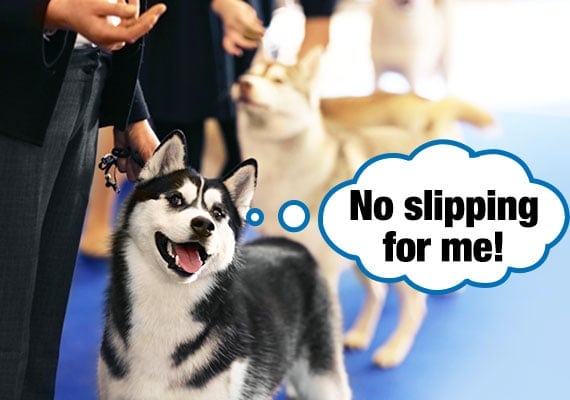
Have you ever wondered how show dogs strut their stuff with such confidence? Even across those glossy floors? In competitions, the stakes are high. A slip or tumble could cost your dog the gold medal. Not leaving anything to chance, owners coat their dog’s pads in an anti-slip spray, like Bio-Groom Show Foot.
The good news is that this product works just as well at home as it does at the dog show. Aim the can at your dog’s paw pads and give a good spray. Once dry, it’s almost unnoticeable and doesn’t leave a sticky residue – no one will guess that your dog is having traction issues.
The spray lasts about a day. Since you will need to reapply regularly, this is best used as a temporary anti-skid solution. I spoke to some service dog owners who keep a can of this spray in their handbag and coat their dog’s paws if they come across a slippery surface away from home, such as epoxy floors.
11. Apply Adhesive Paw Grips
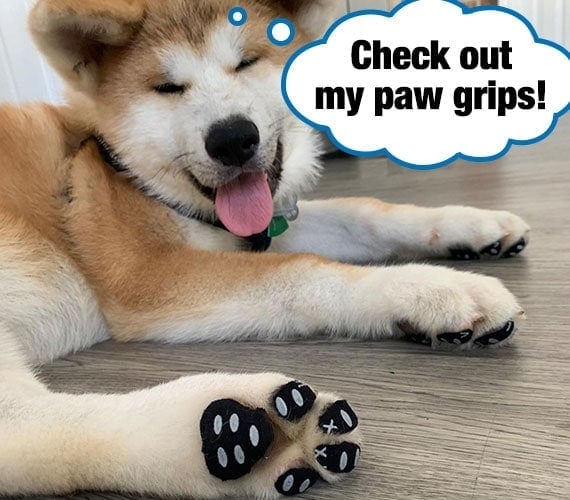
Paw grips are stickers that go on the bottom of your dog’s feet. They go on like a band-aid. Peel back the protector and stick it directly to your pup’s paw pad. Each paw grip features a non-slip pattern that holds strong when pressed against hardwood or vinyl flooring. A popular pick, Loobani Dog Paw Pads come in a packet of 12 sets, which should last a couple of weeks before they run out. You can extend this time by only applying the grippers to the back two paws rather than all four feet.
I’ll be honest, this was perhaps my least favorite non-slip solution. First, you have to make sure you buy the right size for your dog. I have used these on three different dogs now, and not once did the sizing match the dog’s paw – I had to cut each paw gripper to size.
Next, you have to clean each paw pad before applying the gripper. By doing this, you will ensure the pads stick for as long as possible. But even if you do that, you’ll only get 2-5 days of wear before the adhesive loses stickiness and the grips fall off. After that, you need to repeat the whole process. While they may not be my cup of tea, many other dog owners report success when using paw grips. Me? I’ll be sticking with the other options on this list.
12. Put Anti-Slip Tape On Stairs
If your dog struggles with slipping on stairs or other areas of your home, adding clear, non-slip flooring tape could be the simple solution you’re looking for. Trazon Anti-Slip Clear Tape is a fantastic option, as it provides a safe, grippy surface without interfering with the look of your floors. The tape adheres securely to hard surfaces like tile, wood, or laminate, creating a textured grip that helps your dog navigate without sliding.
Most anti-slip tape brands, like Trazon, are also waterproof, making this a great choice for outdoor use. If you have a deck or patio where your dog tends to slip, the tape will hold up even in wet conditions, ensuring your dog has the grip they need to move around safely. This feature also makes it an excellent addition to areas around your dog’s food and water bowls, where spills are common and slipping hazards are more likely.
13. Replace Your Flooring
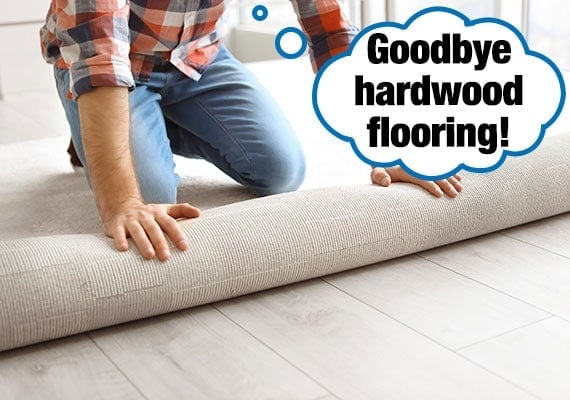
Carpet, foam, or rubber are just a few materials dogs can effortlessly grip. If you want to replace your flooring on the cheap, consider interlocking rubber floor tiles. These are often used when setting up a gym or exercise area in the home. Best of all, dogs will have no problem gripping the rubber surface as they walk over it.
Another more attractive option is interlocking carpet tiles, like these ZENOWICK 12 Pcs Plush Interlocking Carpet Tiles. I love interlocking floor tiles because they can be placed over your existing flooring. When they are no longer needed, they can be removed without damaging your hardwood floor underneath.
Building a new home or renovating? When planning, why not consider a non-slip flooring option for your dog? It doesn’t need to be the whole house, only in rooms or areas where your dog spends most of his time. Carpet, in particular, provides excellent traction for dogs.
14. Train For Steady Paws
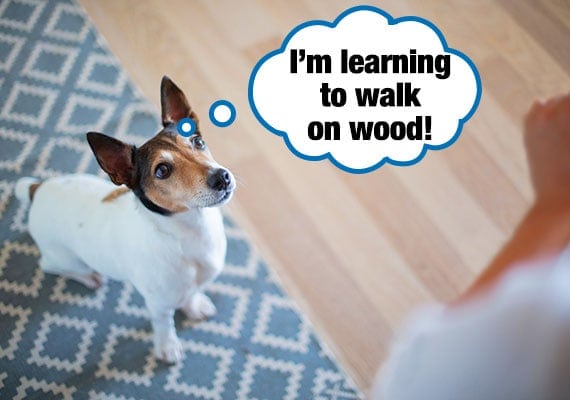
Some dogs are outright afraid of walking on a slippery floor. This can lead them to be extra cautious as they walk across a slippery floor. Unfortunately, awkwardly walking across the floor can only make the problem worse. Or your dog might be so terrified of your tiles that he will avoid walking on them altogether. Waiting at the doorway, anxiously looking at you – he wants to come in but can’t overcome his fear.
Often, the only way to overcome this fear of walking on slippery surfaces is to train the behavior out of your dog. We recommend working with a behaviorist or a positive-reinforcement trainer who can help your dog overcome their fears. Doggy Dan is an excellent resource for at-home training methods that can help dogs on a variety of issues including anxiety in certain situations like walking on hardwood floors.
15. Visit Your Vet

If your dog is constantly slipping and falling on your hardwood floors, the issue may not be your floors at all—it could be an underlying medical condition. Several health problems can make it much harder for dogs to maintain their balance, especially on slippery surfaces. It’s important to recognize that these challenges are often beyond your dog’s control, and a veterinary assessment may be needed to address the root cause.
- Physical Injuries: One common cause of instability is physical injuries such as a torn cranial cruciate ligament (CCL), a luxating patella (where the kneecap moves out of place), a sprained joint, or even a broken leg. These injuries can lead to pain, weakness, or limping, making it harder for dogs to walk properly.
- Arthritis & Joint Issues: Arthritis in the hips, knees, or other joints results in stiffness, swelling, and pain, making movement painful and reducing your dog’s ability to walk without slipping. Age-related joint problems can affect your dog’s mobility, making it harder for them to maintain balance, especially on slippery floors.
- Hip Dysplasia: Hip dysplasia is a genetic condition where the hip joint doesn’t develop properly, causing discomfort, loss of stability, and difficulty distributing weight evenly while walking or running.
- Spine & Nerve Issues: Intervertebral disc disease (IVDD) and other nerve trauma can lead to damaged nerves, affecting a dog’s ability to properly control movement and maintain balance, resulting in falls on slick surfaces.
- Degenerative Myelopathy: Degenerative myelopathy is a progressive spinal cord disease that gradually weakens a dog’s hind limbs, causing coordination problems, difficulty walking, and an increased likelihood of slipping.
- Vestibular Disease: Vestibular disease is a disorder affecting the inner ear, which impacts a dog’s balance and coordination, leading to disorientation and instability, especially on slick or uneven floors.
Symptoms of these conditions may be invisible when walking on easy-to-grip surfaces. However, once your dog steps onto slippery flooring, they can be easily spotted. It’s at this stage that you may miss the medical issue and blame the flooring instead.
Do you suspect that the cause of your dog slipping could be medical? Take your dog to the vet for a check-up. Don’t delay in seeing a vet. If caught in the early stages, many of these medical issues are treatable or manageable – your pup will have a better life for it!
Unfortunately, the anti-slip solutions featured on this list are unlikely to be but so effective if your dog is slipping due to a medical condition. If you have tried a variety of different products and none seem to work, then it may be a clue that your dog has a health issue. But for healthy pups, the non-slip solutions featured above will make your dog as sure-footed as a mountain goat.
How Pet Insurance Can Help
Pet insurance is essential for your dog’s long-term health and happiness, providing financial support for unexpected veterinary costs like accidents, illnesses, or surgeries. With insurance in place, you can seek the highest quality care without the stress of financial burdens, enabling you to prioritize your dog’s health above all else.
Our team of pet insurance specialists has identified the best pet insurance options available, making it simpler for you to choose the right plan for you and your dog. Additionally, you can utilize our free pet insurance quote form below to compare rates from our preferred providers.
When Your Dog Needs Extra Mobility Assistance
Older dogs and those with debilitating health conditions often require special gear to help them get around while maintaining as much independence as possible. Ways you can improve your pup’s mobility include setting up a dog ramp for your bed or sofa (and even for your car), assisting your pup using a sling lift, and getting your furry friend a doggie wheelchair. Pups with joint issues can also benefit from an orthopedic dog bed to help them sleep much more comfortably.
How do you stop your dog from sliding around on slippery flooring? Got a tip to add? Let me know in the comments below!
Why Trust Canine Journal?
Dr. Sara Ochoa, DVM, is a practicing veterinarian in a small animal hospital in East Texas. Dr. Sara earned her Doctorate in Veterinary Medicine from St. George University and has over 7 years of experience working as a veterinarian for Whitehouse Veterinary Hospital in Whitehouse, TX. Prior to vet school, she attended Louisiana Tech for her undergraduate degree and also went back to LSU for clinical rounds after completing veterinary school. With years of experience in the field, she is a treasure trove of knowledge on all things animal-related.
